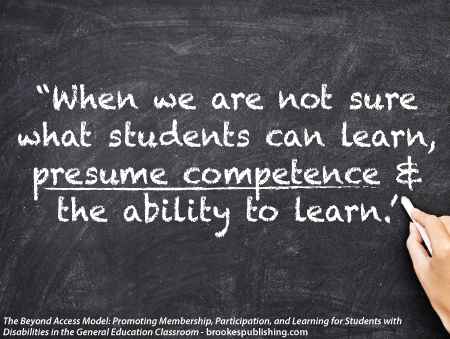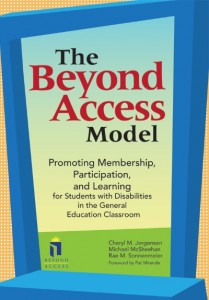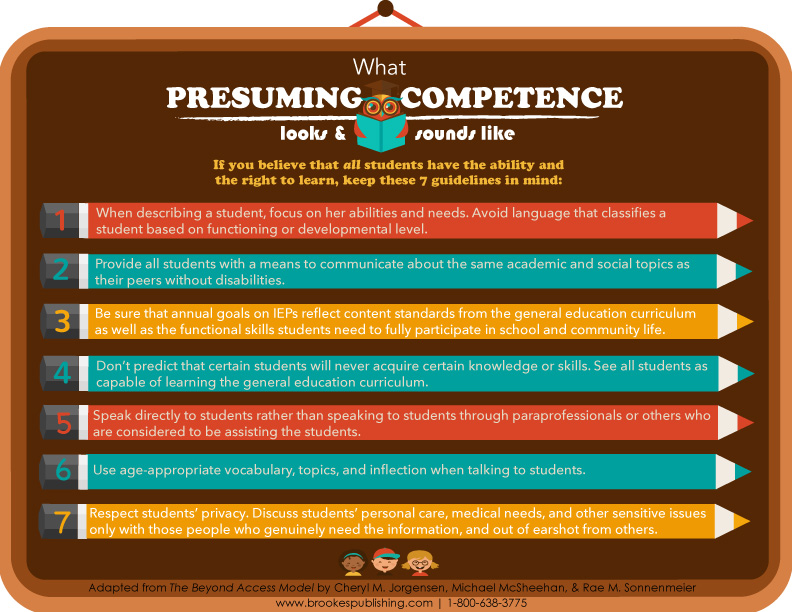Presuming Competence: What It Is, What It Looks Like
May 12, 2015
If you’re already on board with inclusive education, you probably know all about the concept of presuming competence and can cite the benefits in your sleep. But if you’re just joining #TeamInclusion, you might have questions. If a student has a severe disability, how can I presume he can learn what the other kids are learning? Shouldn’t we be more realistic?
In her book The Beyond Access Model, Cheryl Jorgensen does a great job of explaining why presuming  competence is the LEAST dangerous option for students with disabilities. She makes five key points, which I’ll paraphrase here:
competence is the LEAST dangerous option for students with disabilities. She makes five key points, which I’ll paraphrase here:
- Intelligence is multifaceted. Using a test as a sole measure of intelligence doesn’t really capture the full picture of a student’s capacity for learning.
- For students who have complex communication needs and movement challenges, it’s difficult to accurately assess IQ scores.
- When people with intellectual disability have high-quality instruction and an effective way to communicate, many demonstrate that they’re much more capable than originally presumed.
- Presuming incompetence could result in harm to students if we’re wrong.
- If it turns out we’re wrong about a student’s ability to learn the content their peers are learning–it’s okay, because we haven’t harmed the student by presuming competence (that’s why it’s called “the least dangerous assumption”). The potential consequences of NOT presuming competence are much more dangerous to the student.
So what does “presuming competence” look like in action? How does it affect the way a teacher speaks to and about students? Here are seven general guidelines, adapted from Beyond Access, for what presuming competence looks and sounds like:
- When describing a student, focus on her abilities and needs. Avoid language that classifies a student based on functioning or developmental level.
- Provide all students with a means to communicate about the same academic and social topics as their peers without disabilities.
- Be sure that annual goals on IEPs reflect content standards from the general education curriculum as well as the functional skills students need to fully participate in school and community life.
- Don’t predict that certain students will never acquire certain knowledge or skills. See all students as capable of learning the general education curriculum.
- Speak directly to students rather than speaking to students through paraprofessionals or others who are considered to be assisting the students.
- Use age-appropriate vocabulary, topics, and inflection when talking to students.
- Respect students’ privacy. Discuss students’ personal care, medical needs, and other sensitive issues only with those people who genuinely need the information, and out of earshot from others.
Like these reminders? We made a graphic for you to share around and print for your corkboard. And stay tuned–in future posts, we’ll give you specific tips on how to “walk the talk” and ensure that all your students reach their full potential as learners.
SHARE THE GRAPHIC
Would you add anything to the list above? How do you show your students you believe in their ability to learn? Tell us in the comments!





Write a Comment
Your email address will not be published. Required fields are marked *
comments
Michelle says
Thank you for this post. One of the things I love about your work is how contmpeece is presumed no matter the body/mind that it comes in. Many times I provide the anchor because of my abilities not my disabilities (wheelchair user). So my goddaughter's blind mom reaches things high on a shelf for me and I am a quick guide for her while we are out walking in unfamiliar places. We can both figure out solutions to these when we are on our own, but working together provides an important anchor to each of us.
Sherry says
Everyone is capable of learning it may not be in the same time frame as the curriculum states that it should be learned.
Post a Comment